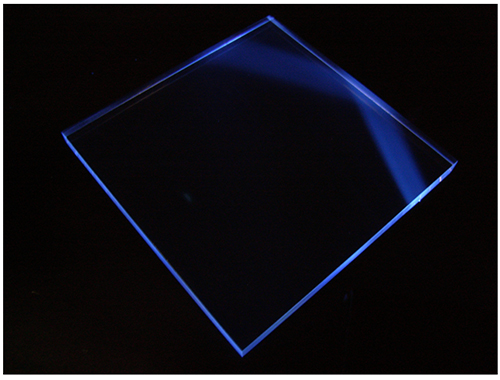October 17, 2013
Assistant Professor Hidehito Nakamura (guest collaborative researcher from the National Institute of Radiological Sciences and a member of the Chiba Science City Strategic Committee), Deputy Director Professor Sentaro Takahashi and Assistant Professor Nobuhiro Sato of Kyoto University, Radiation Protection Officer Yoshiyuki Shirakawa and Section Head Hisashi Kitamura of the National Institute of Radiological Sciences, and Group Leader Osamu Shinji and Staff Member Katashi Saito from Kurary Co. Ltd., have reported major improvements in the propagation of light generated by radiation in highly purified plastics.
The research was published in the issue of "Applied Physics Letters" on October 16, 2013.

Fig: Highly-purified Polystyrene
Background
Plastics that emit light when exposed to radiation are widely used in particle and nuclear physics experiments, and have been integral to radiation measurements in decontamination operations such as that in Fukushima Prefecture. A better understanding of the behavior of light emitted by plastics because of radiation will enable improved measurements of radiation or radioactivity.
This research team manufactured high-purity (>99.9%) polystyrene plastic that exhibits a much greater propagation distance for ultraviolet light than that of general-use polystyrene. Additionally, in-depth analysis of the ultraviolet light propagation revealed that values for the refractive index that were based on the longer-wavelength sodium D-line (589nm) were inaccurate. Instead, the team calculated a highly reliable and much more accurate "Effective Refractive Index" that considers the wavelength distribution of light generated by the radiation.
These findings will contribute significantly at the fundamental level to the design of light propagation in radiation measurement devices, and will have far-reaching effects from particle physics experiments to optical fibers (e.g., scintillation fibers or wavelength shifters) that are used in high-performance radiation measurements and decontamination cleanup.
Research Methods and Findings
Basic data that characterizes the propagation of light generated by radiation includes the light attenuation length (defined as the distance in which the light intensity decreases by 0.36), the reflectivity, and the refractive index. The attenuation length of ultraviolet light in normal polystyrene plastic is only 1mm. The research team produced highly-purified polystyrene (>99.9%) to study in greater detail the behavior of light produced by radiation. The attenuation length of the highly purified polystyrene was much longer (41.6mm) than that found in general-use polystyrene. Additionally, the group devised a mathematical function that goes beyond the standard index based on the sodium D-line and describes an "Effective Refractive Index" (Neff=1.67) that considers the entire spectrum of light generated by radiation. By doing so, they can increase the accuracy in radiation measurements. This function is generally applicable to other materials that generate light.
Spillover Effects
This research has provided a better understanding of the behavior of light in plastics, and a more comprehensive understanding of the nature of light produced by radiation. In particular, applications using plastic optical fibers have dramatically improved the reliability of data based on outputted values, as well as in the initial values that are used in simulations to replicate the behavior of light propagation. Thus higher performance can now be realized for the measurement of radiation or radioactivity.
This study was carried out with the cooperation of the National Institute of Radiological Sciences and Kuraray Co., Ltd.
Paper Information
[DOI] http://dx.doi.org/10.1063/1.4824467
Hidehito Nakamura, Yoshiyuki Shirakawa, Hisashi Kitamura, Nobuhiro Sato, Osamu Shinji, Katashi Saito and Sentaro Takahashi
"Light propagation characteristics of high-purity polystyrene"
Applied Physics Letters, 103, 161111 (2013)

